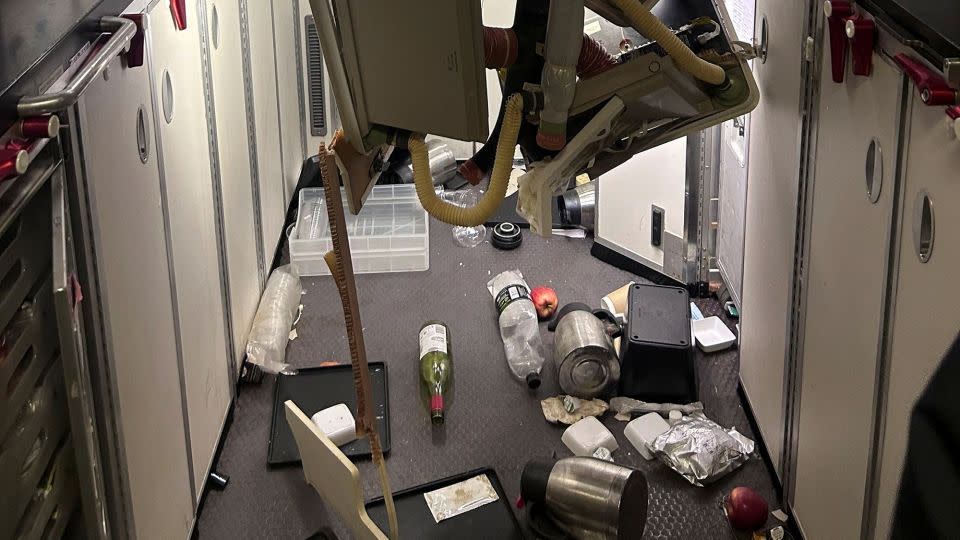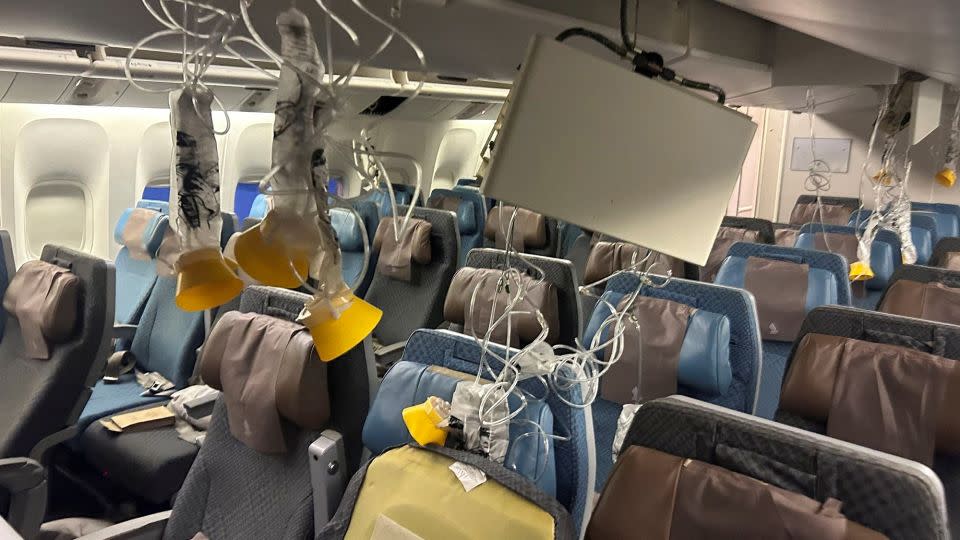One dead and at least 71 injured after severe turbulence hits Singapore Airlines flight
One passenger died and 71 people were injured when their Singapore Airlines flight from London to Singapore encountered severe turbulence Tuesday, throwing passengers and crew around the cabin and forcing the plane to make an emergency landing in Bangkok.
The Boeing 777-300ER was about 10 hours into its flight and midway through meal service when it hit turbulence while flying over Myanmar’s Irrawaddy Basin, according to the airline.
Andrew Davies, a passenger onboard flight SQ321 who was traveling to New Zealand for business, told CNN’s Erin Burnett that it had been a “perfectly normal” flight when the seatbelt sign came on and seconds later “all hell broke loose.”
“The plane just felt like it dropped. It probably only lasted a few seconds but I remember vividly seeing shoes and iPads and iPhones and cushions and blankets and cutlery and plates and cups flying through the air and crashing to the ceiling. The gentleman next to me had a cup of coffee, which went straight all over me and up to the ceiling,” Davies said.
Davies said he realized the “gravity” of the turbulence when he turned around, describing several passengers with gashes on their heads, including one with “blood pouring down her face” and an elderly passenger in “severe shock.”
“There was so much screaming,” he said.
Video and images from inside the aircraft showed the extent of the damage, with overhead compartments smashed open and emergency oxygen air masks hanging down from the ceiling. A photo of one galley showed a section of the ceiling open with parts of the plane’s interior hanging down. Trays, containers, plastic bottles and hot beverage pots can be seen strewn across the floor.
A 73-year-old British man died in the incident from a suspected heart condition, the General Manager of Bangkok’s Suvarnabhumi International Airport Kittipong Kittikachorn said Tuesday, adding that the autopsy process was still ongoing.
The man was later identified as Geoff Kitchen, who was described as “always a gentleman with the utmost honesty and integrity” by the Thornbury Musical Theatre Group (TMTG), an establishment where he worked for over 35 years.
The British Foreign Office told CNN it was supporting the family of a British passenger who died on a Singapore Airlines flight.
Davies, who was seated toward the front of the plane, said he helped tend to Kitchen, who was seated behind him.
“Lots of people needed some help but we tended to this gentleman and I helped carry him, get him out of the seat, and we lay him on the floor so that some medical profession(als) could administer CPR,” Davies said, adding the passenger was administered CPR for about 20 minutes.”
The Samitivej Srinakarin Hospital in Bangkok, which received the injured passengers, said at least 71 people were injured, with six severely. Those injured include citizens of Malaysia, the UK, New Zealand, Spain, the US and Ireland.
Kittikachorn, who inspected the aircraft, said some injured passengers sustained broken arms.
The flight, carrying 211 passengers and 18 crew, had left London’s Heathrow Airport around 10:30 p.m. local time, according to online flight trackers. It was bound for Singapore’s Changi Airport, however the aircraft was diverted to Bangkok where it landed at 3:45 p.m. local time, according to the airline.
Video filmed after Singapore Airlines SQ321 was diverted to Bangkok shows a passenger being carried from the aircraft on a stretcher by emergency responders.
Kittikachorn said that following the landing in Bangkok almost 200 travelers were waiting to take onward flights to their destinations. A Singapore Airlines plane carrying 131 of the 211 passengers later departed Bangkok for Singapore, he said.
Singapore Airlines CEO Goh Choon Phong said in a statement that the airline is “providing all possible assistance and support” to the passengers and their families.
“On behalf of Singapore Airlines, I would like to express my deepest condolences to the family and loved ones of the deceased passenger. We also deeply apologize for the trauma experienced by all passengers and crew members on this flight,” he said.
Singapore’s Ministry of Transport said in a statement that it was investigating the situation involving flight SQ321 and the US National Transportation Safety Board is sending personnel to Singapore to help support the investigation.

Flight likely encountered rapidly developing thunderstorms
Turbulence occurs when a plane flies through clashing bodies of air moving at widely different speeds.
With light and moderate turbulence passengers might feel a strain against their seatbelt, and unsecured items could move around the cabin. But in severe cases turbulence can throw passengers around the cabin, causing severe injuries and occasionally death.
A statement from the airline said the plane, “encountered sudden extreme turbulence over the Irrawaddy Basin [a river in Myanmar] at 37,000 feet, about 10 hours after departure.”
Data from aviation tracking site FlightRadar24 shows the flight suddenly dipping then rapidly climbing a few hundred feet before dipping and climbing again and then finally settling back at its cruising altitude. The entire disruption took about 90 seconds, according to the data.
The flight changes course about 14 minutes later. The airline said, “The pilot declared a medical emergency and diverted the aircraft to Bangkok.”
The flight likely encountered rapidly developing thunderstorms over southern Myanmar on Tuesday during the time that extreme turbulence was reported, according to CNN Weather analysis.
Tropical thunderstorms like these are typical for this time of year with moisture increasing in the region as the southwest monsoon season is beginning in South Asia. They can form quickly in the early afternoon as the land heats up, especially near the coastline.
Budding thunderstorms like Tuesday’s may not appear on radar in their earliest stages, even though the quick rising motion within them can still produce turbulence. The storm cells likely grew from 20,000-30,000 feet to well over 50,000 feet in less than an hour.
Turbulence could become more frequent

About 65,000 aircraft suffer moderate turbulence every year in the US, and about 5,500 run into severe turbulence. These numbers, however, might be destined to grow as the climate crisis is modifying some types of turbulence, according to a professor of atmospheric science at the University of Reading in the UK.
A September 2022 study predicts that clear-air turbulence will increase significantly around the globe by 2050-2080, in particular along the busiest flight routes, and the strongest type of turbulence will increase the most.
In March 2023, violent movements on a private jet resulted in the death of a former White House official, though an investigation later found that weather was not involved in that incident. That incident came just days after seven people were transported to hospitals after a separate commercial flight hit significant turbulence.
In July 2023, seven people were injured on a Hawaiian Airlines flight to Sydney, Australia, when the plane was buffeted by severe turbulence, and 36 people were injured on a Hawaiian Airlines flight from Arizona to Honolulu in December 2022, with 20 people taken to emergency rooms.
Singapore Airlines is often considered one of the world’s safest carriers.
Its only previous fatal accident was in October 2000 when flight SQ006 crashed when the Boeing 747-400 took off from a closed runway in Taiwan amid heavy rain, killing 83 on board.
Singapore Airlines said later Tuesday that a dedicated team had arrived in Bangkok “to support our colleagues and the local authorities on the ground” in an update on its Facebook page.
The flight operator expressed its “deepest condolences to the family of the deceased. We deeply apologize for the traumatic experience that our passengers and crew members suffered on this flight.”
Boeing has said it is in touch with the Singaporean carrier and is “ready to support them.” The manufacturer is deferring further questions to the airline and local authorities.
This story and headline have been updated with additional developments.
CORRECTION: An earlier version of this story incorrectly described a March 2023 incident involving a private jet. The National Transportation Safety Board later ruled weather had not been involved in the violent movements of that plane.
CNN’s Jack Guy, Lauren Said-Moorhouse, Steven Jiang, Catherine Nicholls, Ross Levitt, Hamdi Alkhshali, Brandon Miller and Sharon Braithwaite contributed to this report.
For more CNN news and newsletters create an account at CNN.com

